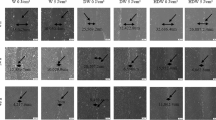Abstract Patients with diabetes mellitus experience impaired wound healing often resulting in chronic foot ulcers. Hospital discharge data indicate that 6–20% of all diabetic individuals hospitalized (mostly with type 2 diabetes) have a lower extremity ulcer. Maintaining glucose levels at acceptable levels (below 10 mmol/l) is considered to be an important part of the clinical treatment, but the exact mechanism by which diabetes delays wound repair is not yet known. We studied this phenomenon by determining the potential of fibroblasts isolated from the ulcer sites of four patients with non-insulin-dependent diabetes mellitus to proliferate in vitro. Controls were fibroblasts isolated from normal skin of the upper leg of five healthy age-matched volunteers and of six non-insulin-dependent diabetes patients. Proliferative capacity was analysed by evaluation of plates after trypsinization and [3H]thymidine incorporation. Fibroblast morphology was studied by light and transmission electron microscopy. Diabetic ulcer fibroblasts, measured by [3H]thymidine incorporation, proliferated significantly more slowly than the nonlesional control fibroblasts (P < 0.00047) and age-matched control fibroblasts (P < 0.00003). After culturing the fibroblasts for a prolonged period in high-glucose (27.5 mM) and low-glucose (5.5 mM, i.e. physiological) medium, this difference in proliferation rate between diabetic ulcer fibroblasts and nonlesional diabetic fibroblasts remained (P < 0.0001 for high-glucose and P < 0.0009 for low-glucose on day 7). Fibroblast proliferation in all three groups was slightly lower in high-glucose than in low-glucose medium, although not significantly at any time-point. Light microscopy showed diabetic ulcer fibroblasts to be large and widely spread. Transmission electron microscopy of cultured diabetic ulcer fibroblasts and nonlesional diabetic skin fibroblasts revealed a large dilated endoplasmic reticulum, a lack of microtubular structures and multiple lamellar and vesicular bodies. These results show a diminished proliferative capacity and abnormal morphology of fibroblasts derived from diabetic ulcers of non-insulin-dependent diabetes patients.
Similar content being viewed by others
Author information
Authors and Affiliations
Additional information
Received: 23 March 1998 / Received after revision: 12 October 1998 / Accepted: 16 October 1998
Rights and permissions
About this article
Cite this article
Loots, M., Lamme, E., Mekkes, J. et al. Cultured fibroblasts from chronic diabetic wounds on the lower extremity (non-insulin-dependent diabetes mellitus) show disturbed proliferation. Arch Dermatol Res 291, 93–99 (1999). https://doi.org/10.1007/s004030050389
Issue Date:
DOI: https://doi.org/10.1007/s004030050389




